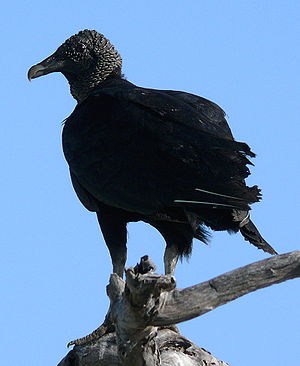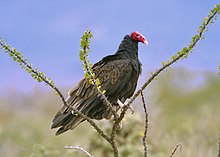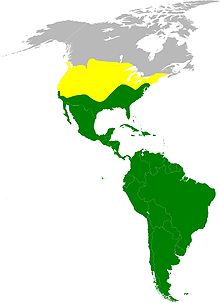New World Vulture
| New World Vulture | ||||||||||||
|---|---|---|---|---|---|---|---|---|---|---|---|---|

Black vulture ( Coragyps atratus ) |
||||||||||||
| Systematics | ||||||||||||
|
||||||||||||
| Scientific name | ||||||||||||
| Cathartidae | ||||||||||||
| Lafresnaye , 1839 |
The New World vultures (Cathartidae) is a family of birds of prey , which on the double continent America living vultures includes. They are only distantly related to the Old World vultures , which all belong to the extremely species-rich family of the hawk-like .
The New World vultures include seven species. The best-known of them is the Andean condor ( Vultur gryphus ), one of the largest airworthy birds on earth and next to the wandering albatross the one with the largest wingspan. Other well-known species are the California condor , turkey vulture, and black vulture . The king vulture , the great yellow-headed vulture and the lesser yellow-headed vulture do not live in North America .
distribution and habitat
New World vultures are found throughout South and Central America and the United States . The largest range is the turkey vulture, which lives from Tierra del Fuego and the Falkland Islands to about the southern border of Canada , but leaves the northern and central USA to the south in winter. New World Vultures live in almost all habitats in their range. In contrast to the Old World vultures, which inhabit open landscapes, they also occur in forests and closed bushland. The most adaptable species is the turkey vulture, which lives in both forests and deserts. It has expanded its habitat far north in recent decades, primarily feeding on dead animals that have fallen victim to road traffic. The black vulture, which was originally a resident of wetlands and river banks, has become a cultural follower and is native to many cities in Central and South America. He looks for his food in the garbage, especially in the garbage from the fish markets.
features
New World Vultures are 64 centimeters to 1.34 meters long, reach a wingspan of 1.37 to 3.20 meters and a weight of 850 g to 11 kg. Their plumage is mainly dark or black, in adult king vultures the predominant color is white. In small species there is no sexual dimorphism , either in terms of size or shape. In the king vulture and California condor, the males are about 10% larger than the females. Male Andean condors grow 25% larger; they also differ significantly from female birds in their black plumage (that of the female is dark brown), the white ruff and wing feathers, the fleshy crest on the vertex and the rather reddish head.
Comparison with the old world vultures
The New World vultures differ from the Old World vultures in their lack of a nasal septum and a well-developed sense of smell. The nostril is in the tip of the beak. Old World vultures nest on trees or ledges, the New World vultures do not build nests.
nutrition
New World vultures are primarily scavengers . However, turkey and black vultures also kill defenseless prey, especially small or very young animals such as lizards or young birds in the nest. Black vultures scour beaches for newly hatched sea turtles . They are also accused of attacking newborn lambs and calves. It is more likely, however, that they are just waiting for the afterbirth in the case of cattle giving birth . Both species also eat insects , berries, and other fruits and dung from larger mammals. The three species of the genus Cathartes can also track down the carcasses of very small animals with their good sense of smell.
As with Old World vultures, there is a fixed hierarchy between the different species on larger carcasses. Only the two types of condor are able to tear the skin of larger dead mammals. The king vulture dominates the rainforests and can open medium-sized carcasses of monkeys or sloths . Black vultures mainly eat muscle meat and intestines . The three species of the genus Cathartes eat much more slowly and mainly gnaw off meat remains from the bones.
Reproduction

Little is known about the reproductive behavior of most New World vultures. No species nests in colonies. The great yellow-headed vulture has never been observed nesting, the small yellow-headed vulture only once, the king vulture only a few times. The species that have already been observed during reproduction do not build a nest, but lay their eggs on ledges, in large tree hollows and in tree stumps directly on the ground. The two condors nest on inaccessible rocky outcrops in the mountains, while the nests of the smaller species are in locations that are more accessible to predators. The birds behave very clandestinely when they approach or move away from the nest. A putrid carrion odor emanating from the nests of some species could also deter predators from visiting. Older, but not yet flight-capable young birds often move away from the nests. The nests are not strongly defended by the adult birds, and nests plundered by predators are the main cause of breeding failure.
The two types of condor lay only a single egg, while black vultures and turkey vultures usually lay two. The eggs are whitish, those of the turkey vulture, which uses more open breeding grounds, are spotted. In the species that have been observed during brood care, the pair partners take turns breeding. The breeding period ranges from 40 days for the smaller species to 55 days for the condors. The young have a fine down dress , which is white for the condors, the king vulture and the turkey vulture, and brown for the black vulture. You are likely to be able to keep yourself warm early on. Turkey vultures visit their chicks for feeding only a few minutes a day. The feed is brought to the young in the crop and not with the catch. First of all, the parents feed the young with their beak, later the food is placed on the ground and the young birds take it in independently. Young condors do not fledge until they are three months old, but then stay with their parents for months. Raising a single young takes over twelve months for both types of condor. One brood in one year therefore requires a breeding break in the following.
Small species of New World vulture are likely to reach sexual maturity at three years of age. Captive condors do not begin breeding activities until they are six years old. The California condor is likely monogamous , and the black vulture is also believed to have long-term couples.
Tribal history
New World vultures have a longer fossil-proven tribal history than most other bird families and appear with the two genera Palaeogyps and Phasmagyps for the first time in the early Oligocene 35 million years ago. First, New World vultures also occurred in the Old World , as did Old World vultures in the New World. However, there are no fossil remains of New World vultures in Europe, Asia or Africa that are younger than the early Miocene , about 20 million years ago. Old World vultures survived in America until the late Pleistocene 10,000 years ago. A common ancestor of the Andean condor and king vulture is known from the Pliocene five million years ago . Since the early Pleistocene two million years ago, the black vulture, the turkey vulture and the California condor have been found in fossil records along with other, now extinct, New World vultures.
From the Miocene to the Pleistocene there was a closely related family, the Teratornithidae , which included Teratornis and Argentavis as the largest flying birds known to this day.
Systematics
The New World vultures were initially assigned to birds of prey in the traditional sense (Falconiformes). But as early as 1876, Huxley noticed that they were different from all other birds of prey. It has been known for more than a hundred years that they share some characteristics with the storks (Ciconiidae). These include, above all, the bone structure, the anatomy of the skull and the arrangement of some muscles. Like storks, they cool themselves by wetting their legs with excrement. Molecular biological methods finally opened up new possibilities for investigating relationships in the late 20th century. According to their new bird systematics based on DNA hybridization , Charles Gald Sibley and Jon Edward Ahlquist classified the New World vultures as a subfamily in the stork family. The Sibley-Ahlquist taxonomy , however, did not find general acceptance, and the New World vultures were as independent family within the waders out (Ciconiiformes).
In the 1990s, DNA hybridization was replaced by DNA sequencing , which enables the direct comparison of DNA from the cell nucleus (ncDNA) or from the mitochondria ( mtDNA ). Corresponding investigations initially showed that the New World vultures are not closely related to the walking birds. The South American Classification Committee (SACC) of the American Ornithologists' Union therefore separated the New World vultures from the wading birds. A subsequent analysis showed, with a rather weak bootstrap value of 61%, a position of the New World vultures as the most basal taxon of a clade, which contains all groups traditionally regarded as birds of prey with the exception of the falcon-like . The SACC then placed the New World vultures in their own, monotypical order (Cathartiformes) due to their relatively insecure sister group relationship with the other predatory birds .
The International Ornithological Congress (IOC) summarized the New World Vultures, according to the latest results, but again with most of the groups traditionally classified as birds of prey, the falcon-like (Falconidae) no longer being included. Since the taxon with the scientific name "Falconiformes" must include its type genus Falco ( falcon ), this newly defined group of carnivorous birds has been given the name Accipitriformes. The following cladogram shows a hypothesis about the closer relationship of the New World vultures :

| Birds of prey (Accipitriformes) |
|
||||||||||||||||||
|
|
Genera and species

There are seven species in five genera. Four of the genera are monotypical .
-
Cathartes
- Turkey vulture ( C. aura )
- Lesser yellow-headed vulture ( C. burrovianus )
- Great yellow-headed vulture ( C. melambrotus )
-
Coragyps
- Black vulture ( C. atratus )
-
Gymnogyps
- California condor ( G. californianus )
-
Sarcoramphus
- King Vulture ( S. papa )
-
Vultur
- Andean condor ( V. gryphus )
swell
General
- Josep del Hoyo , Andrew Elliott, Jordi Sargatal and David A. Christie (Eds.): Handbook of the Birds of the World . Volume 2: New World Vultures to Guinea Fowl. Lynx Edicions, Barcelona 1994, ISBN 84-87334-15-6 .
Individual evidence
- ^ Alan Feduccia: The Origin and Evolution of the Birds. 2nd ed., Yale University Press, New Haven / London, 1999, ISBN 0-300-07861-7
- ^ Charles Sibley, Jon Ahlquist (1990): Phylogeny and classification of birds . Yale University Press, New Haven, Connecticut, ISBN 0-300-04085-7
- ↑ Per G. P. Ericson, Cajsa L. Anderson, Tom Britton, Andrzej Elzanowski, Ulf S. Johansson, Mari Källersjö, Jan I. Ohlson, Thomas J. Parsons, Dario Zuccon, Gerald Mayr: Diversification of Neoaves: integration of molecular sequence data and fossils. Biology Letters, Vol. 2, No. 4, 2006, pp. 543-547, doi: 10.1098 / rsbl.2006.0523 (alternative download at senckenberg.de )
- ↑ Proposal (# 241) to South American Classification Committee Remove Cathartidae from the Ciconiiformes ( Memento of the original from June 28, 2010 in the Internet Archive ) Info: The archive link was inserted automatically and has not yet been checked. Please check the original and archive link according to the instructions and then remove this notice. , August 2006
- ↑ SJ Hackett, RT Kimball, S. Reddy, RCK Bowie, EL Braun, MJ Braun, JL Chojnowski, WA Cox, K.-L. Han, J. Harshman, C. Huddleston, BD Marks, KJ Miglia, WS Moore, FH Sheldon, DW Steadman, CC Witt and T. Yuri: A Phylogenomic Study of Birds Reveals Their Evolutionary History. Science. Vol. 320 (No. 5884), 2008, pp. 1763–1768 doi: 10.1126 / science.1157704
- ↑ Proposal (# 361) to South American Classification Committee Place Cathartidae in their own order ( Memento of the original from June 28, 2010 in the Internet Archive ) Info: The archive link has been inserted automatically and has not yet been checked. Please check the original and archive link according to the instructions and then remove this notice. , June 2008
- ^ Frank Gill and Minturn Wright: BIRDS OF THE WORLD Recommended English Names. Princeton University Press, 2006, ISBN 0-7136-7904-2
- ^ IOC World Bird List ( Memento from December 5, 2013 in the Internet Archive )
- ↑ Families in the order Accipitriformes ( Memento of the original from October 26, 2010 in the Internet Archive ) Info: The archive link was inserted automatically and has not yet been checked. Please check the original and archive link according to the instructions and then remove this notice.
- ↑ Excerpt from the result of a comprehensive analysis based on nuclear DNA with 169 species representing all important recent groups of birds, see: Shannon J. Hackett, Rebecca T. Kimball, Sushma Reddy and 15 other authors: A phylogenomic study of birds reveals their evolutionary history. Science. Vol. 320, No. 5884, 2008, pp. 1763-1768, doi: 10.1126 / science.1157704 .
- ^ Name of the taxa according to John Harshman: Accipitriformes . Version dated June 27, 2008. The Tree of Life Web Project



